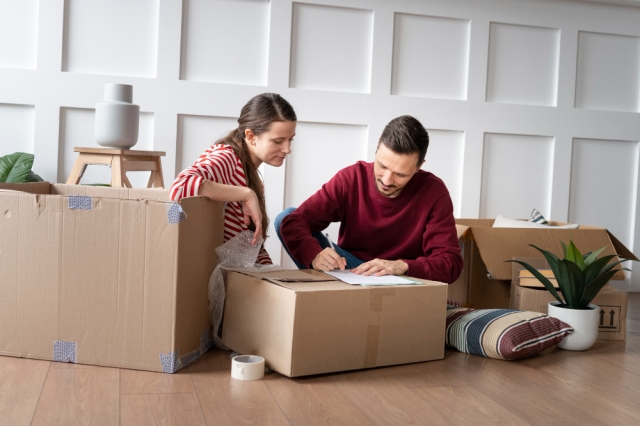Moving is one of life's major transitions—and for many, it's one of the most stressful. Between boxing up your life and adjusting to a new home, it's easy to feel overwhelmed. However, the difference between chaos and calm often comes down to organization. That's where purposeful packing comes in.
Rather than scrambling at the last minute or misplacing half your belongings, you can take an innovative and structured approach. These professional tips will guide you through every stage—from early planning to post-move unpacking. With some intention and preparation, you can stay in control and minimize stress.
Pre-Move Planning for Success
Create a Moving Timeline
A moving timeline is your roadmap to a smoother relocation. Begin by identifying your move date, then work backward to plot out when tasks must be completed. This could include when to start packing certain rooms, contacting movers, and beginning decluttering. By breaking everything down by week, you create structure and avoid the panic that comes with procrastination.
Having deadlines also makes the workload feel more manageable. Instead of facing the entire move simultaneously, you're checking off smaller, achievable goals. Whether you use a digital calendar or a printed checklist, stick to the schedule as best. You'll have a strong foundation to fall back on even if surprises come up—as they often do.
Declutter Before You Pack
Before you start packing, it's critical to streamline your belongings. Moving is the perfect excuse to evaluate what you use and need. Start with one room at a time and sort items into four piles: keep, donate, sell, and toss. This step will help lighten your load and give you fewer things to pack, move, and eventually unpack.
Decluttering also saves money. Most moving companies charge based on weight or volume, so reducing what you bring can cut costs. Plus, your new space will feel more open and intentional if it's not cluttered. The key is to be honest with yourself—if you didn't need it in your old place, you probably won't need it in the new one either.
Use a Labeling System That Works
Labels might seem like a small detail, but they significantly impact a move. An effective labeling system prevents confusion, speeds up the unloading process, and helps you locate items when needed. Consider using color-coded stickers or labels for each room or number of boxes and keep a corresponding inventory list. Whichever method you choose, stay consistent.
Be specific when writing labels. "Kitchen – Dishes" is far more helpful than simply "Kitchen." Label at least two sides of each box to identify contents even if boxes are stacked. If you're using movers, this system also helps them know exactly where each box goes, saving everyone time and energy on a moving day.
Pack an Essentials Box
An essentials box is your first day or two survival kit in your new home. Pack it immediately with things you'll need: toiletries, medications, snacks, a couple of outfits, phone chargers, essential tools, and toilet paper. You won't want to dig through 10 boxes to find your toothbrush or a clean pair of socks.
Think of it as packing for a short hotel stay. Include any daily-use items that will make your first night more comfortable. If you're moving with kids or pets, customize their essentials boxes. Label these boxes clearly and keep them in your vehicle, not the moving truck.
Hiring Movers – What You Need to Know
Research and Compare Moving Companies
Choosing the right movers can make or break your experience. Start by researching local companies online. Look for verified reviews and whether they're licensed and insured. Narrow your list to three or four, and ask each for a written estimate based on your inventory.
When evaluating potential movers, focusing on expert moving companies with high professionalism and experience is essential. Don't focus only on price. Consider what services are included, how professional they seem, and how responsive they are to your questions. A company that communicates clearly and provides transparent pricing is far more reliable than one that gives you a vague quote with hidden fees.
Ask the Right Questions
Before you sign a contract, get specific. Ask about their cancellation policy, liability coverage, and whether they charge extra for stairs, long carries, or delays. Confirm who will be handling your move—some companies subcontract to other teams, which can affect the quality and accountability of the service.
Also, clarify what packing services are available if you need help boxing things up. Knowing what's included ensures you're not caught off guard on a moving day. The more you understand upfront, the smoother the process and the fewer surprises you'll face.
Stay Organized on Moving Day
Moving day is all about execution. Have your moving checklist ready and keep important items—keys, contracts, IDs, essentials box—with you. Greet the movers when they arrive and give them a quick walk-through of your home. Be available to answer questions and provide direction as needed.
Before the truck pulls away, do one final sweep of your old place. Check closets, cabinets, drawers, and even the attic. It's easy to leave something behind in the rush. Once everything's on the truck, lock up and take a deep breath—you've made it through the hard part.
Smart Packing Techniques
Pack Room by Room
Packing room by room brings order to the process. It lets you focus your energy and prevents a messy mess of mixed-up belongings. Start with the rooms you use least, like the guest room or storage areas, and work toward the high-traffic zones, like the kitchen and bedroom. This step-by-step method creates a logical flow.
Sticking to one space at a time makes it easier to unpack later. When every box from the bathroom is grouped, you can fully set up that room without rummaging through unrelated boxes. It may take more discipline up front, but it saves considerable frustration once you arrive in your new space.
Use the Right Packing Materials
Using quality packing materials protects your belongings and gives you peace of mind. Invest in sturdy boxes, strong packing tape, bubble wrap, and packing paper. Avoid overused or flimsy boxes—they're more likely to break under pressure. Specialty boxes for dishes, wardrobes, or electronics can be worth the extra cost.
Don't forget about creative solutions using what you already own. Soft household items like towels, bedding, and sweaters can double as protective cushioning. Wrap fragile items with these materials to save on supplies and reduce waste. Label those boxes clearly so you're not surprised to find your favorite hoodie wrapped around a vase.
Protect Fragile and Valuable Items
Fragile items need extra attention. Wrap each one individually with packing paper or bubble wrap, and fill the space inside the box to prevent shifting. Don't overload fragile boxes—too much weight increases the risk of damage. Make these boxes "Fragile" and indicate which side should face up.
It's best to keep valuables like jewelry, passports, financial documents, and sentimental items with you during the move. Even the most careful movers can misplace or mishandle small, high-value items. Having them close reduces the chance of loss and gives you one less thing to worry about.
Don't Overpack Boxes
It's tempting to stuff as much as possible into each box, but overpacking is a common mistake. Heavy boxes are rigid to lift and more likely to break. Pack heavy items like books in smaller boxes and use larger ones for lighter items like linens and pillows for safety and ease.
Balance is key. You want each box to be complete enough to avoid collapsing but not so heavy it becomes unmanageable. Before taping a box shut, give it a lift. If it's difficult to carry comfortably, remove a few items and redistribute the weight. This keeps everyone—your back included—happy on a moving day.
Post-Move Organization
Unpack with Purpose
Unpacking can feel overwhelming, but it doesn't have to be. Start with the essentials, then tackle one room at a time. Avoid ripping open every box at once—it just creates more mess. Focus first on setting up spaces that affect your daily routine: the kitchen, bathrooms, and bedrooms.
As you unpack, use the opportunity to organize. Put things away with intention rather than just getting them out of boxes. This is your chance to set up systems that work in your new home. Don't rush the process—give yourself a few days or weeks to get fully settled in.
Final Thoughts
Packing with purpose doesn't just help you stay organized—it reduces stress, saves time, and makes you feel more in control during a major life transition. Whether moving alone or with an entire household, applying these tips will set you up for success.
Remember, every step you take to plan pays off later. With a clear strategy, the right supplies, and a bit of patience, you'll be well on your way to a smooth, stress-free move. And once you're settled in, you'll be glad you did it correctly.






